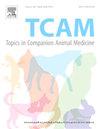3只家兔膀胱腹股沟中线腹壁疝的诊断与治疗。
IF 1.3
3区 农林科学
Q2 VETERINARY SCIENCES
引用次数: 0
摘要
由于成年雄性的腹股沟环在整个生命周期中保持开放,因此在兽医文献中已经很好地描述了家兔(Oryctolagus cuuniculus)通过腹股沟环的膀胱腹股沟疝。由于各种病因,包括创伤、切口裂开和先天性异常,在一些兽医物种中也描述了中线体壁突出。这种现象以前没有在兔子身上被描述过。本病例系列描述了三只成年雄性完整兔子,在三个不同的机构出现了不明原因的腹部中线肿胀。一只兔子在入院前食物摄入量减少,尿频,尿失禁;一只兔子无精打采,不愿动弹;一只兔子没有任何临床症状。所有病例均经影像学诊断为膀胱突出,并选择手术修复。在手术解剖疝囊时,发现一只兔子也有小肠袢疝。每个病例分别识别腹股沟环,切除体壁缺损边缘,重建体壁。与之前在兔子身上描述的腹股沟环疝修补术相比,本病例需要改变手术入路。一只兔子在手术后原有的氮血症恶化。手术并发症,包括疝复发,在这三只兔子中没有观察到。膀胱中线体壁突出应被视为鉴别诊断的兔子尾部腹部和/或腹股沟肿胀或泌尿系统疾病的临床症状。本文章由计算机程序翻译,如有差异,请以英文原文为准。
Diagnosis and treatment of inguinal midline abdominal wall herniation of the urinary bladder in three domestic rabbits (Oryctolagus cuniculus)
Inguinal herniation of the urinary bladder through the inguinal rings of domestic rabbits (Oryctolagus cuniculus) has been well-described in veterinary literature due to the inguinal rings remaining open throughout the lifespan of adult males. Midline body wall herniation has also been described in several veterinary species due to a variety of etiologies, including trauma, incisional dehiscence, and congenital anomalies. This phenomenon has not previously been described in rabbits. This case series describes three adult male intact rabbits that presented to three separate institutions with a swelling on ventral midline of unknown etiology. One rabbit had decreased food intake, frequent urination, and urinary incontinence prior to presentation; one rabbit was lethargic and unwilling to move; and one rabbit presented without clinical signs. Herniation of the urinary bladder was diagnosed via imaging in each case and surgical repair was elected. During surgical dissection of the hernial sac, it was discovered one rabbit had a herniated loop of small intestine as well. In each case, the inguinal rings were identified separately, the margins of the body wall defect were excised, and the body wall was reconstructed. This presentation required an altered surgical approach compared to inguinal ring herniorrhaphy procedures that have previously been described in rabbits. One rabbit had worsening of pre-existing azotemia after the procedure. Surgical complications, including recurrence of herniation, were not observed in these three rabbits. Midline body wall herniation of the urinary bladder should be considered as a differential diagnosis in rabbits with caudal abdominal and/or inguinal swelling or clinical signs of urinary disease.
求助全文
通过发布文献求助,成功后即可免费获取论文全文。
去求助
来源期刊

Topics in companion animal medicine
农林科学-兽医学
CiteScore
2.30
自引率
0.00%
发文量
60
审稿时长
88 days
期刊介绍:
Published quarterly, Topics in Companion Animal Medicine is a peer-reviewed veterinary scientific journal dedicated to providing practitioners with the most recent advances in companion animal medicine. The journal publishes high quality original clinical research focusing on important topics in companion animal medicine.
 求助内容:
求助内容: 应助结果提醒方式:
应助结果提醒方式:


